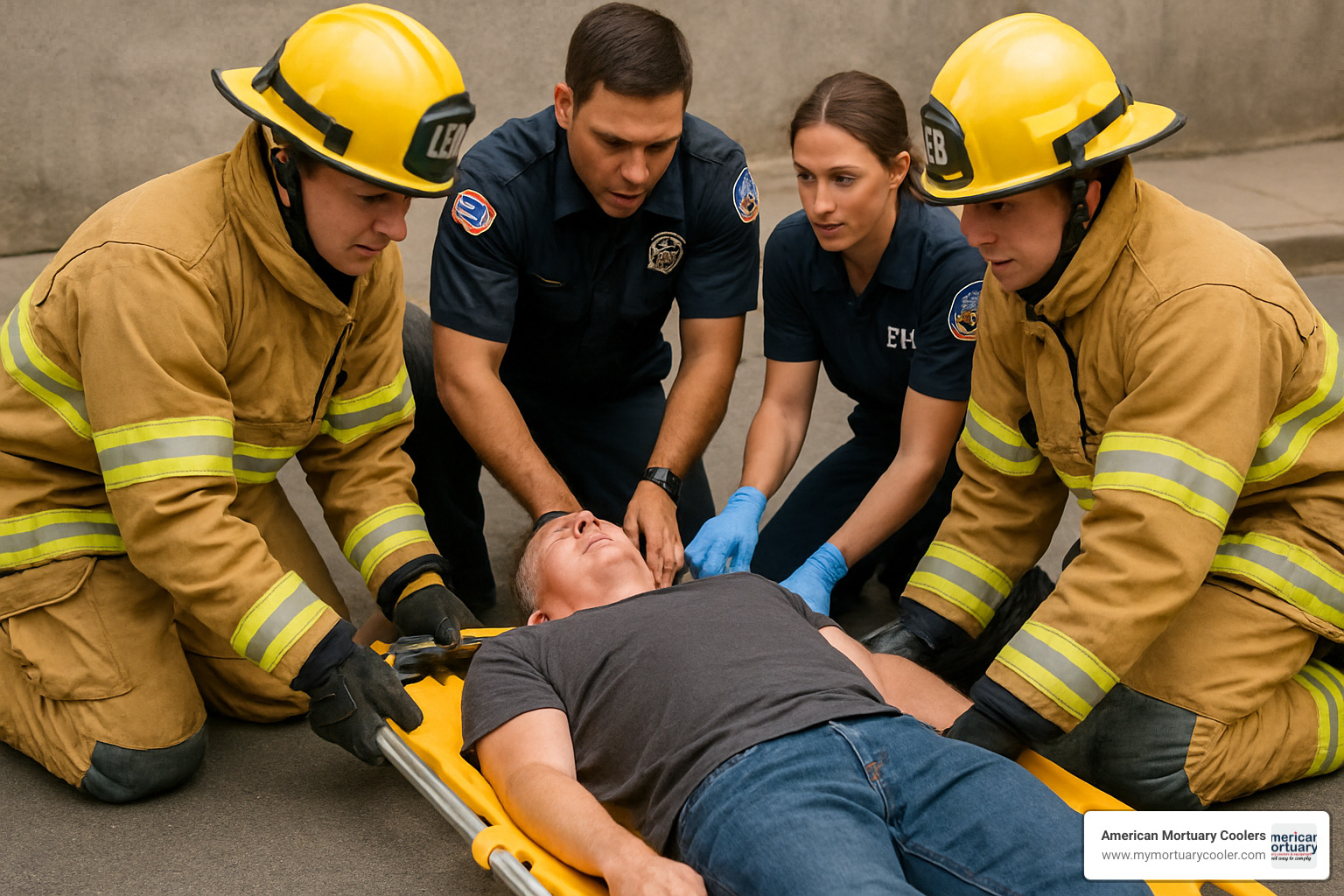The Evolution of Patient Transfer: Introducing Scoop Stretchers
Scoop stretchers are specialized medical devices designed to safely transport patients with suspected spinal or traumatic injuries while minimizing movement. These innovative tools split into two halves that can be positioned around a patient and reconnected, eliminating the need for dangerous log-roll maneuvers.
What is a Scoop Stretcher?
- Definition: A two-part stretcher that separates longitudinally to slide under patients without lifting
- Purpose: Minimizes patient movement during transfers to reduce risk of secondary injuries
- Key Feature: Allows transfer without log-rolling the patient
- Materials: Typically made from lightweight aluminum or high-density polyethylene
- Weight Capacity: Usually supports between 350-500 pounds
- X-ray Compatible: Most models are radiolucent for imaging without patient removal
In emergency medical services, few devices are as essential as the scoop stretcher. A 2022 study showed a 30% reduction in secondary injuries during transport when using scoop stretchers compared to traditional methods. They're particularly valuable for patients with suspected spinal injuries, fractures (especially pelvic or femur), and multi-trauma cases.
Unlike rigid backboards, scoop stretchers are designed with patient comfort in mind while still providing excellent immobilization. The clamshell design allows responders to gently secure patients without the potentially harmful movement associated with other transfer methods.
I'm Mortuary Cooler, a national-level supplier of mortuary equipment with extensive experience helping funeral homes and medical facilities select appropriate scoop stretchers for safe, dignified patient handling. My expertise in scoop stretchers comes from years of working directly with emergency medical professionals to understand their evolving needs and standards.
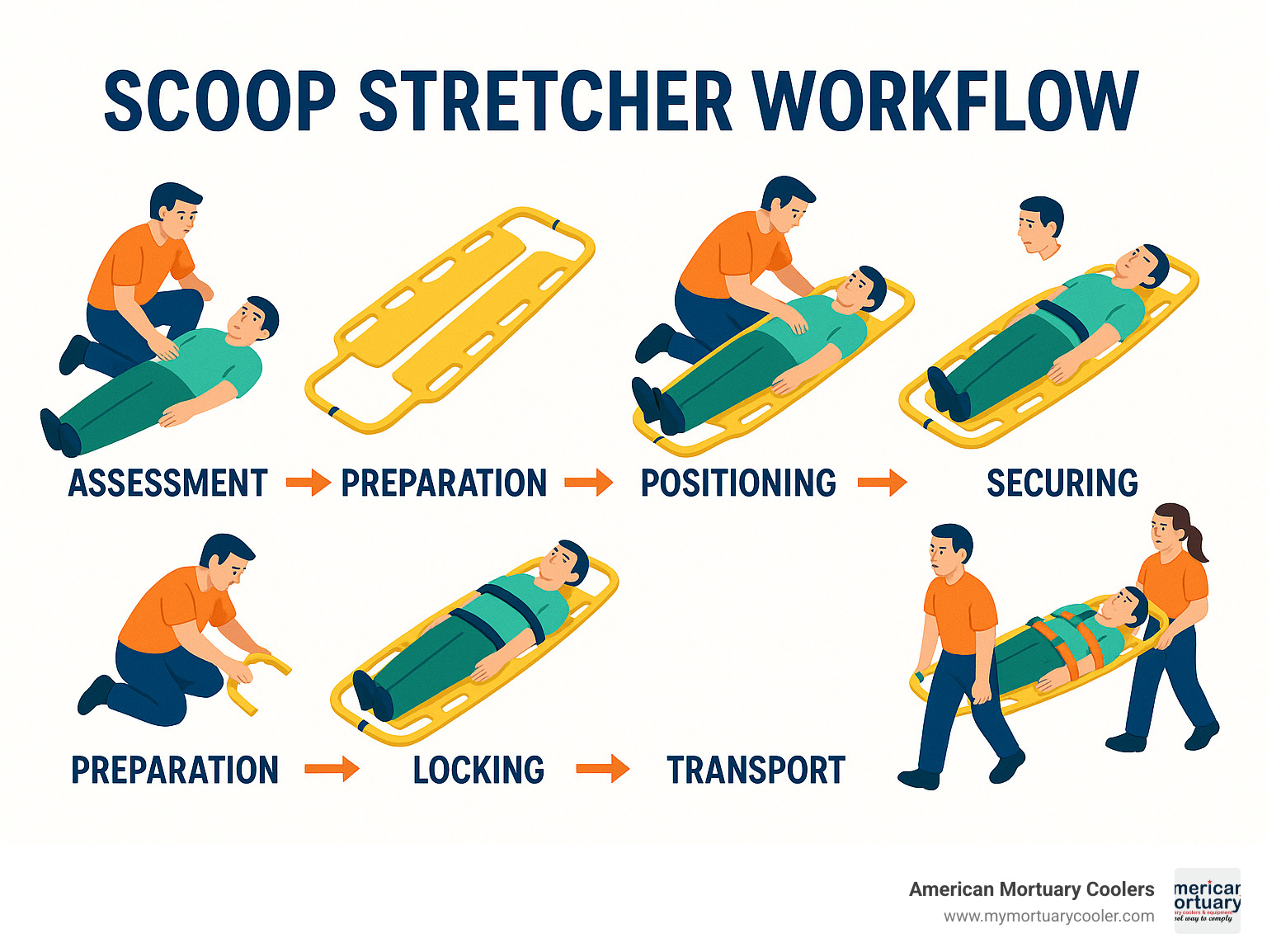
Find more about scoop stretchers:
What Is a Scoop Stretcher and How Does It Work?
Ever wondered how emergency responders move injured patients without making things worse? That's where the magic of a scoop stretcher comes in. Also called a clamshell or Roberson orthopedic stretcher, this clever device flips the script on patient transport: instead of moving the patient to the stretcher, we bring the stretcher to the patient.
The design is beautifully simple yet effective. A scoop stretcher splits vertically into two concave halves that run the entire length of the device. These halves can be gently positioned on either side of a patient who's already lying down. Each half has specially shaped blades that slide smoothly beneath the patient from the sides. Once properly positioned, the halves lock together at both ends, creating a secure unit that cradles the patient's body.
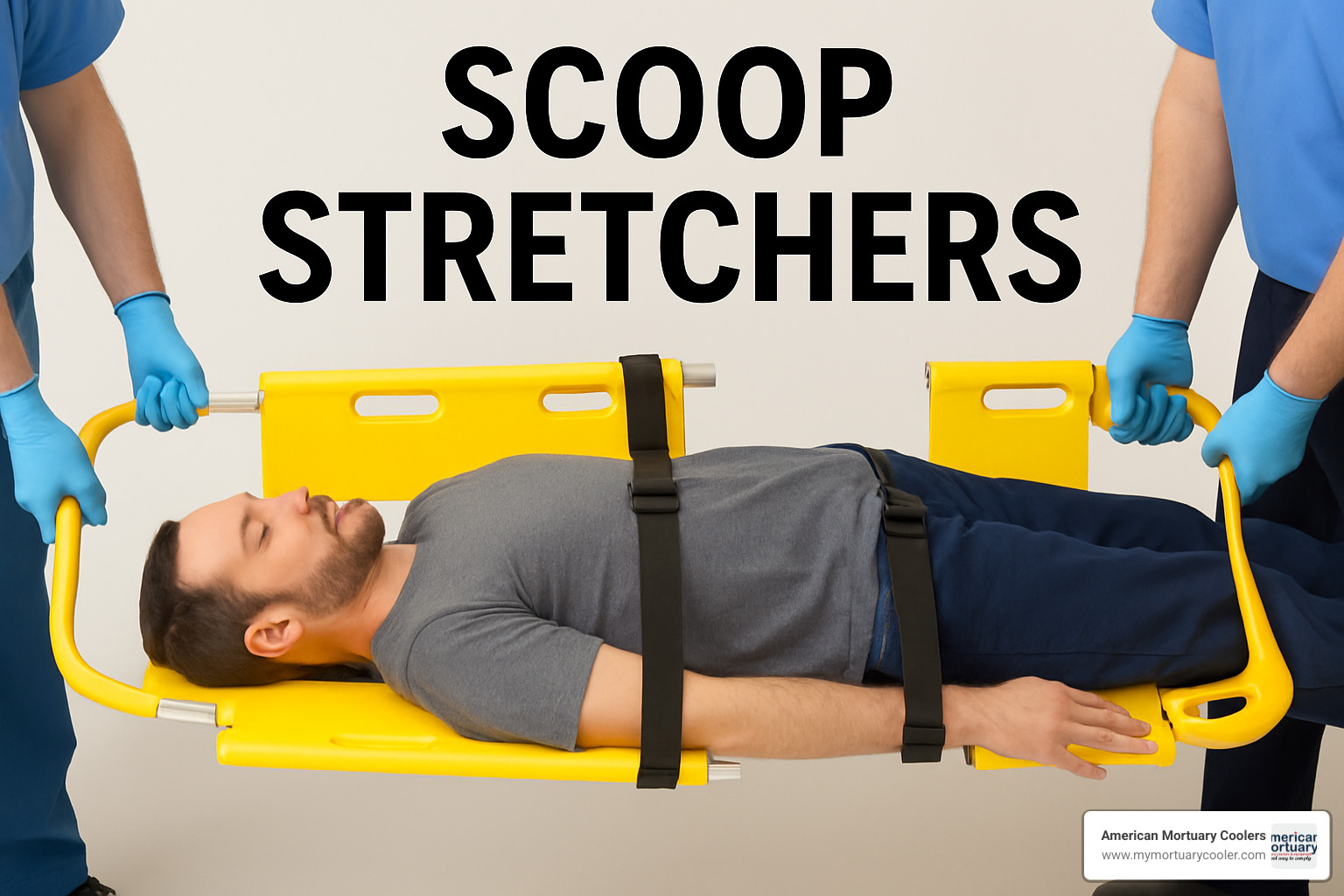
Most modern scoop stretchers come with adjustable length mechanisms – a handy feature that lets rescuers accommodate patients of different heights. This adjustment happens before placing the stretcher, ensuring everything aligns properly from head to toe.
One of the most important aspects of these stretchers is how they maintain proper cervical spine alignment. Many models feature a recessed head section that supports the head while leaving room for cervical collar placement.
According to Scientific research on pre-hospital spinal care, minimizing patient movement during transfer is critical for preventing secondary injuries. Traditional log-roll techniques can create unwanted spinal movement, which is why scoop stretchers have become the preferred option for suspected spinal injuries.
Scoop Stretcher Components & Materials
Today's scoop stretchers are marvels of engineering, balancing functionality with durability. The frames are typically made from one of three materials: high-strength aluminum alloy (offering excellent strength while staying lightweight), high-density polyethylene (HDPE) for durability with reduced weight, or thermally-treated polymer that prevents the surface from becoming uncomfortably hot or cold.
The handles are designed with rescuer comfort in mind. Their oval profiles and angled positioning reduce strain during lifting and carrying. Most models feature multiple strategically placed handles to support team lifting.
The locking mechanism is what brings it all together – literally. Twin safety locks at the head and foot ends secure the two halves, with some advanced models featuring auto-lock systems that engage securely under patient weight. For patient security, scoop stretchers include three or more restraint straps with quick-release buckles.
Weight capacity is a crucial consideration. Most standard models support between 350-500 pounds, though at American Mortuary Coolers, we've noticed the industry trending toward higher capacity models to meet changing patient demographics.
The materials in scoop stretchers serve multiple purposes beyond just structural strength. Most are radiolucent, allowing X-rays to pass through without interference – a huge benefit when time is critical. Their thermal neutrality prevents uncomfortable temperature extremes, while seamless, non-porous surfaces make cleaning and disinfection straightforward.
When and Why to Deploy a Scoop Stretcher in the Field
Let's talk about when these remarkable tools truly shine in emergency situations. Knowing exactly when to reach for a scoop stretcher can make all the difference between a smooth patient transfer and one that potentially worsens injuries.
Primary Indications for Scoop Stretcher Use:
Picture this: you arrive at an accident scene where someone has fallen from a ladder. They're complaining of back pain and can't move their legs. This is precisely when a scoop stretcher becomes your most valuable tool. These devices are perfect for patients with suspected spinal injuries because they allow you to secure the patient with minimal movement.
Pelvic and femur fractures are another scenario where scoop stretchers prove their worth. These painful, often unstable injuries require careful handling, and the gentle cradling action of a scoop stretcher helps maintain alignment while reducing the patient's discomfort during transfer.
When extracting someone from a crumpled vehicle after an accident, the narrow profile and split design of a scoop stretcher lets you position it around the patient once they're accessible. Similarly, in confined spaces like narrow hallways or cluttered apartments where traditional stretchers simply won't fit, the scoop's slimmer profile becomes a lifesaver.
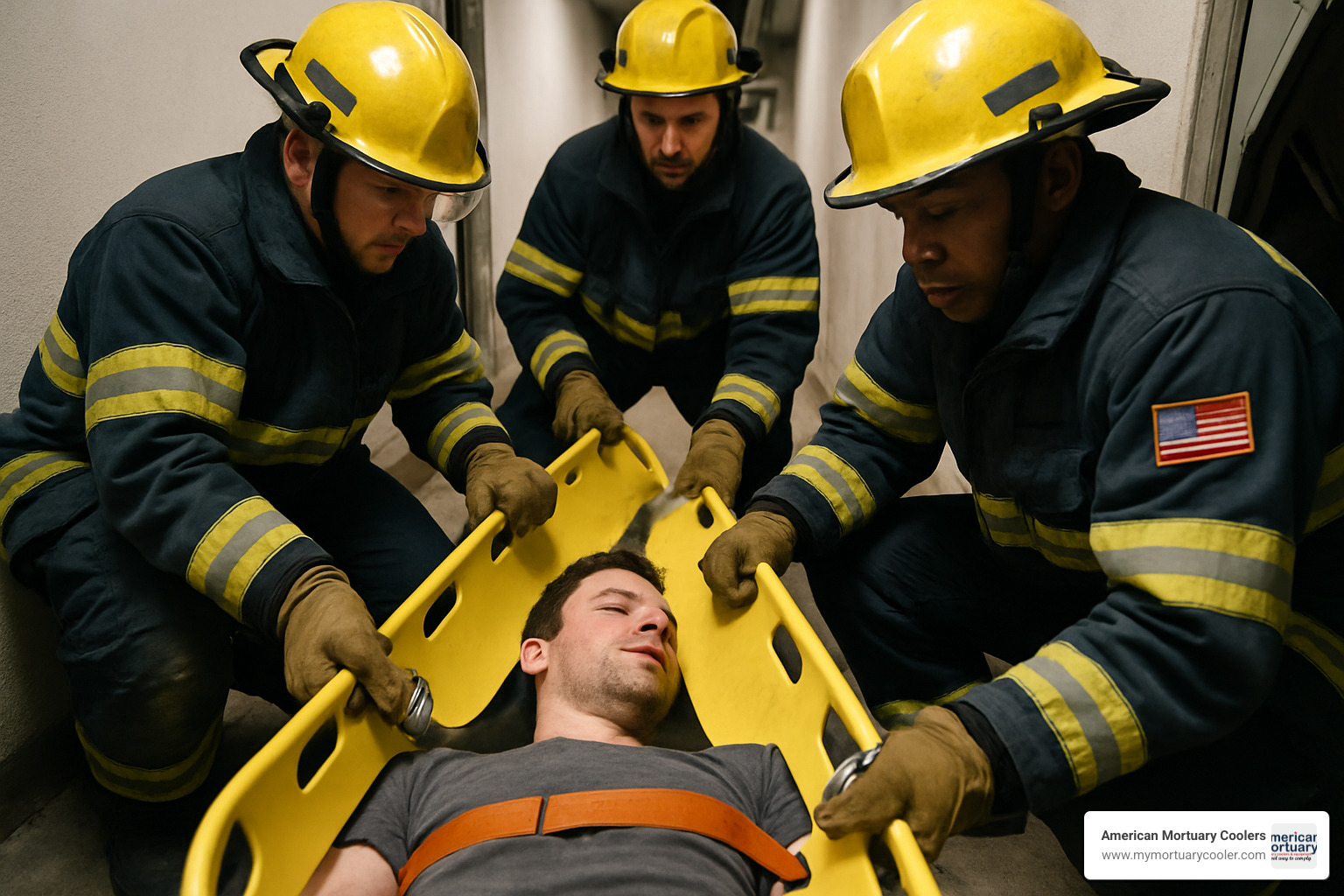
During mass-casualty incidents, when every second counts, the quick application and efficient patient packaging make scoop stretchers invaluable. Teams can rapidly assess, secure, and transport victims when multiple casualties need attention simultaneously.
Many people don't realize that scoop stretchers can be incredibly useful in water rescue operations too. Several models either float naturally or can be fitted with flotation attachments, making them perfect for safely extracting someone from water while maintaining spinal alignment.
I've spoken with countless EMTs who tell me that using scoop stretchers has cut their patient handling time by about 20% compared to traditional methods. When you're working against the clock in that critical "golden hour," those saved minutes can literally save lives.
For a deeper dive into different stretcher types and their specific applications, check out our comprehensive guide on understanding stretchers: types, uses, and names.
Scoop Stretcher vs Backboard vs Basket
When it comes to choosing the right immobilization device, it helps to understand how scoop stretchers compare to their cousins in the emergency response family.
| Feature | Scoop Stretcher | Backboard | Basket Stretcher |
|---|---|---|---|
| Motion Restriction | Excellent for spinal alignment with minimal movement during application | Good for full-body immobilization but requires log-roll for placement | Good overall immobilization but requires lifting patient into basket |
| Patient Comfort | Moderate to good; contoured surface with less pressure points | Poor; rigid surface causes pressure points during extended use | Moderate; depends on padding but generally more comfortable than backboard |
| Imaging Compatibility | Excellent; most are fully radiolucent | Excellent; fully radiolucent | Limited; metal frames interfere with imaging |
| Terrain Versatility | Good on flat surfaces; limited on uneven terrain | Good on flat surfaces; poor on uneven terrain | Excellent; designed for rough terrain and vertical lifts |
It's telling that by 2023, over 60% of emergency response teams in major cities worldwide had made scoop stretchers their go-to choice. This shift reflects growing awareness of their unique advantages in common emergency scenarios.
Choosing a Scoop Stretcher Over Other Devices
The evidence increasingly supports choosing scoop stretchers in many situations. Current Spinal Motion Restriction (SMR) protocols favor them over traditional backboards because they significantly reduce the risk of secondary injuries. That "scooping" action means you don't have to roll the patient, which can be a game-changer when dealing with spinal injuries.
Patient comfort is another compelling reason. Anyone who's spent even a few minutes lying on a rigid backboard knows how uncomfortable they can be. Extended time on these hard surfaces can lead to pain, pressure sores, and even breathing difficulties. Scoop stretchers distribute pressure more evenly, making them kinder to patients during transport.
The ATLS guidelines now recommend transferring patients from scoop stretchers to vacuum mattresses for transport rather than using backboards for extended periods. This two-step approach combines the safe initial transfer of the scoop with the comfort and stability of the vacuum mattress.
Step-by-Step Guide: Using Scoop Stretchers Safely
Let's walk through how to properly use a scoop stretcher – something I've seen many EMS teams perfect over time. While it might look straightforward, proper technique makes all the difference between a smooth transfer and potential patient discomfort.
1. Assess the Scene and Patient
Before you even touch your equipment, take a moment to ensure everyone's safety. Check your surroundings for hazards, complete your initial patient assessment, and determine if spinal precautions are needed. If you suspect a spinal injury, immediately apply manual stabilization to the cervical spine – this simple action can prevent devastating complications.
2. Prepare the Scoop Stretcher
Now it's time to get your equipment ready. Bring the scoop stretcher to the patient's side and separate the two halves by releasing the locks. If your model has adjustable length (most modern ones do), take a quick moment to match it to your patient's height. Always verify that all locking mechanisms work properly – a failure here could compromise patient safety. Place your restraint straps within easy reach for quick access once the patient is loaded.
3. Position the Stretcher Halves
Teamwork is crucial at this stage. Position one responder at the head to maintain that manual C-spine stabilization we started earlier. Other team members should place each half alongside the patient, making sure the head section aligns properly with the patient's head. Clear communication is vital here – make sure everyone knows the plan before proceeding.
4. Slide the Stretcher Under the Patient
This is where the magic of the scoop stretcher happens. Gently slide each blade under the patient from the sides, working from shoulders and hips toward the center. The goal is to minimize spinal movement throughout this process. Take your time to ensure the patient is perfectly centered before attempting to connect the halves.

5. Lock the Stretcher Halves
Bring the two halves together until they meet in the middle, then engage both the head and foot locking mechanisms. Give them a gentle test to verify they're secure – a loose connection could be disastrous during transport. Double-check that no clothing or personal items are caught in the connection points, as this could cause patient discomfort or compromise the stretcher's integrity.
6. Secure the Patient
With your patient now on the fully assembled scoop stretcher, apply restraint straps across their body. At minimum, secure the chest, pelvis, and legs. The straps should be snug enough to prevent movement but not so tight that they restrict breathing or circulation. Add padding where needed for comfort and stability – especially for longer transports.
7. Transport the Patient
Before lifting, take a moment to communicate your plan with the entire team. Use proper body mechanics and team lifting techniques to prevent responder injuries. A clear lifting command helps coordinate the effort – something simple like "Lift on three: one, two, three" works well. Move smoothly to your transport vehicle, and make sure the stretcher is properly secured once inside.
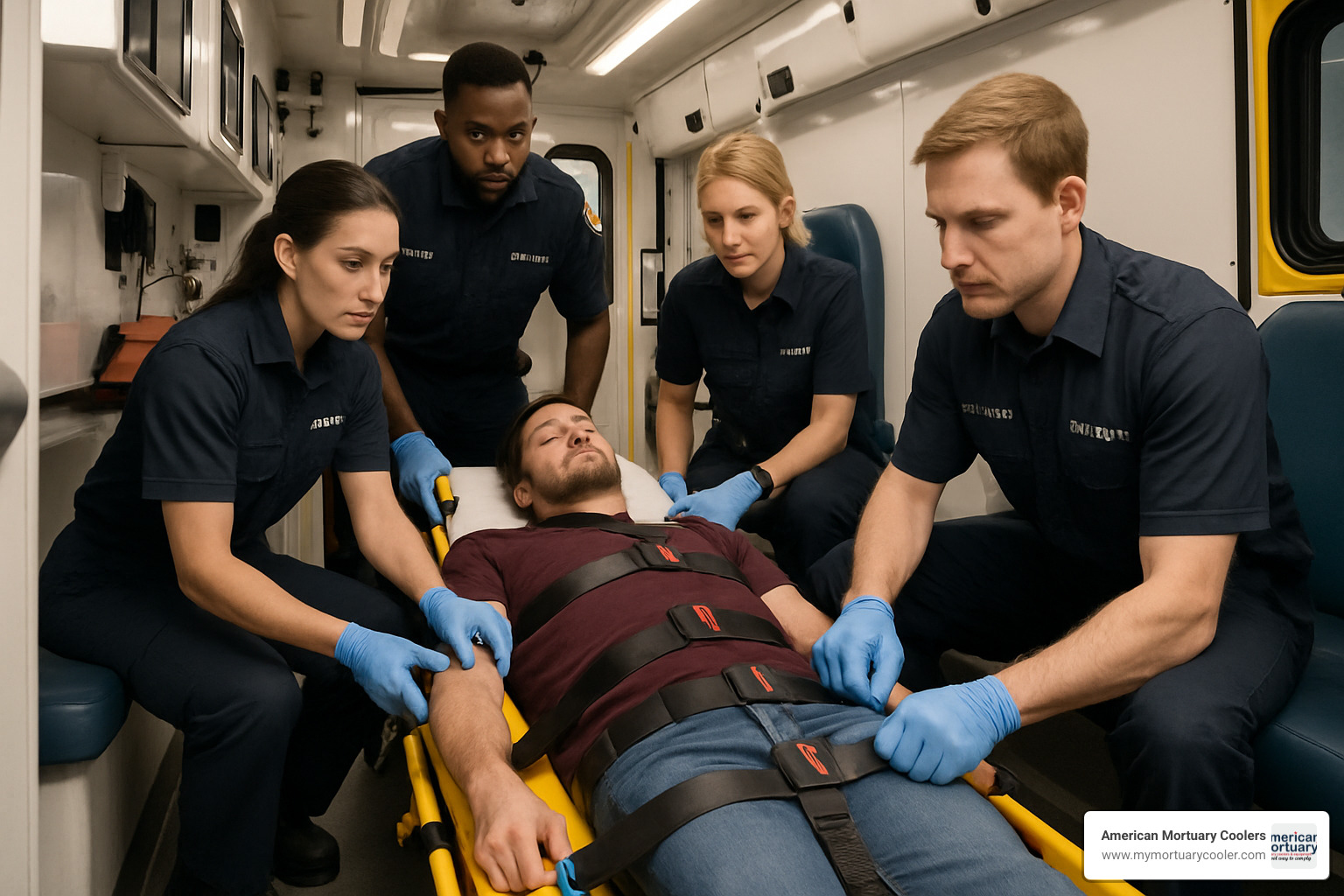
Scoop Stretchers and Spinal Motion Reduction
The beauty of a scoop stretcher isn't just its convenience – it's the remarkable way it protects patients from further harm. Research backs this up: a 2022 study showed a 30% reduction in secondary injuries during transport when using scoop stretchers compared to traditional methods. That's not just an impressive statistic; it represents real people avoiding potentially life-altering complications.
The no-log-roll advantage is perhaps the most significant benefit. Traditional log-rolling techniques, while taught for generations, create concerning movement in the spinal column. By eliminating this roll, scoop stretchers help maintain spinal alignment through several key mechanisms:
Your patient stays in their found position, which is often naturally protective. The splitting design eliminates dangerous twisting forces during transfer. The stretcher maintains pelvic ring stability – crucial for patients with suspected pelvic fractures. And finally, the multiple handles allow your team to distribute lifting force evenly.
For more detailed information about selecting the best medical stretchers for your specific needs, visit our guide on best medical stretchers.
Advantages, Limitations, and Modern Innovations
When it comes to patient transfer equipment, scoop stretchers have revolutionized how we handle trauma patients. As someone who's worked with emergency services across the country, I've seen how these clever devices make life better for both patients and responders.
Key Advantages
You know what makes scoop stretchers truly special? Speed. A 2021 study showed they cut patient handling time by about 20% compared to old-school methods. When minutes count in emergency situations, that's a game-changer.
Patient comfort is another major win. Instead of the flat, unforgiving surface of a traditional backboard, most scoop stretchers have a gentle curve that better supports the body's natural contours. This means fewer pressure points and less pain during transport – something your patients will definitely appreciate.
For hospital teams, the radiolucent design of modern scoop stretchers is invaluable. X-rays can pass right through the material, allowing medical staff to perform imaging without moving the patient again. One less transfer means one less chance for complications.
Storage space is always at a premium in ambulances and rescue vehicles. That's why the foldable design of many scoop stretchers is such a practical feature. They tuck away neatly when not in use, leaving room for other essential equipment.
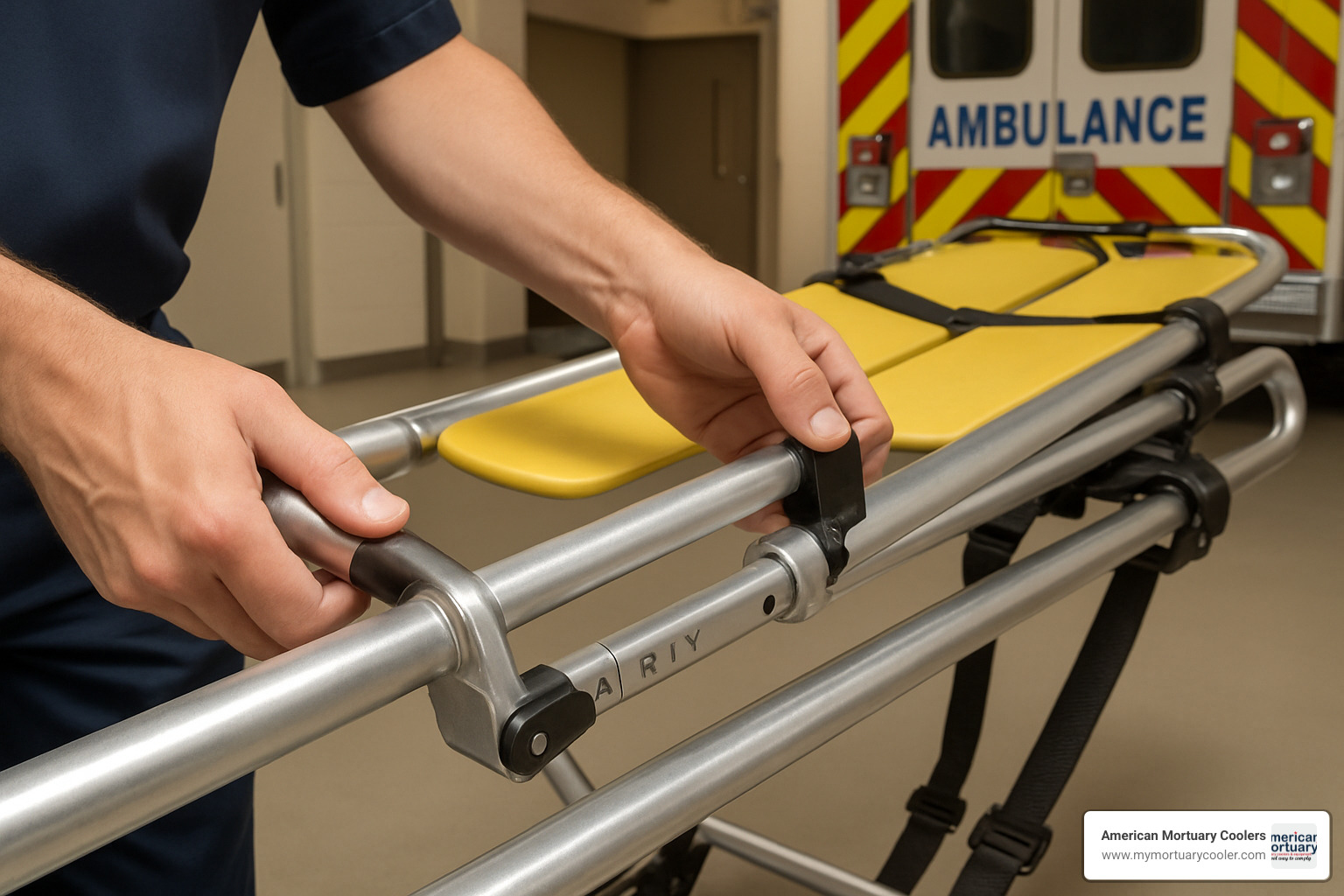
Limitations to Consider
Let's be honest – no piece of equipment is perfect for every situation. Scoop stretchers typically have weight capacities between 350-500 pounds, which means you'll need specialized bariatric equipment for heavier patients.
There are also specific scenarios where scoop stretchers aren't ideal. Patients with impaled objects or certain exposed fractures might be better served with alternative transfer methods. And while they're versatile, extremely uneven or steep terrain can be challenging – that's where basket stretchers really shine.
Training is another consideration. Your team needs proper instruction and regular practice to use scoop stretchers effectively. It's not complicated, but there are techniques that make the difference between a smooth transfer and a struggle.
Modern Innovations
The scoop stretcher of today is miles ahead of its ancestors. One of my favorite innovations is the dual-function combi board – a clever hybrid that combines the functions of a scoop stretcher and an extrication board in one device. This means less equipment to buy, store, and maintain.
Lock mechanisms have gotten smarter too. The latest auto-lock systems engage securely under patient weight, eliminating concerns about accidental separation during transport. It's one less thing for busy responders to worry about.
Materials science has transformed these devices as well. Modern composite materials provide better strength-to-weight ratios while maintaining that all-important radiolucency. The result? Lighter stretchers that are easier on responders' backs but still tough enough for daily use.
Many manufacturers now offer integrated head immobilization systems that work perfectly with their scoop stretchers. This compatibility eliminates the need for separate devices and ensures better overall spinal protection.
A PubMed study on spinal motion restriction confirms what we've seen in practice – modern immobilization techniques using devices like scoop stretchers significantly reduce harmful movement compared to traditional methods.
Frequently Asked Questions about Scoop Stretchers
Are scoop stretchers radiolucent?
Yes, most modern scoop stretchers are designed to be radiolucent, meaning X-rays and other imaging can pass through them without interference. This is a game-changer in trauma situations, as it allows medical staff to take crucial images without moving the patient off the stretcher.
Think about it – when someone has a suspected spinal injury, the last thing you want to do is unnecessarily move them around. With a radiolucent scoop stretcher, doctors can get the images they need while keeping the patient stable and secure.
The level of radiolucency does vary between materials though. The high-density polyethylene (HDPE) models typically offer the clearest images, while aluminum versions might show up faintly on X-rays but generally won't obscure important details.
When should I choose a scoop stretcher over a backboard?
The decision between using a scoop stretcher or a traditional backboard isn't always straightforward, but there are definitely situations where the scoop is clearly the better choice.
First and foremost, when you need to minimize patient movement, scoop stretchers shine. By eliminating the need for the log-roll maneuver (where you roll the patient onto their side), you're reducing the risk of causing further injury to an already compromised spine. This is why so many EMS agencies have updated their protocols to favor scoop stretchers for suspected spinal injuries.
Patient comfort is another major factor. Let's be honest – backboards are basically torture devices if you have to lie on them for more than a few minutes. The contoured design of most scoop stretchers distributes pressure much more evenly, reducing the risk of painful pressure ulcers during longer transports.
Working in tight spaces? The split design of a scoop stretcher is a lifesaver when you're trying to extricate someone from between furniture, in a narrow bathroom, or any other confined space where maneuvering a full backboard would be impossible.
That said, backboards still have their place. They provide a more rigid surface for CPR, work better for rapid extrication scenarios, and can be preferable for very short transport times.
What training do EMTs need to operate scoop stretchers?
Using a scoop stretcher might look simple, but proper training is essential for both patient safety and responder confidence. From our experience working with emergency services across the country, we've seen that the most effective training programs cover several key areas.
Basic EMT education should include hands-on practice with scoop stretchers, covering everything from assembly and disassembly to proper patient assessment and application techniques. EMTs need to understand not just how to use the device, but when it's appropriate to choose it over other options.
Regular skill sessions are crucial for maintaining proficiency. The best training scenarios simulate real-world conditions – practicing in confined spaces, coordinating with multiple team members, and integrating the scoop stretcher with other equipment like vacuum mattresses or ambulance stretchers.
Since emergency medicine is constantly evolving, continuing education is vital too. New research on spinal motion restriction, updates to protocols, and innovations in equipment design all impact how scoop stretchers should be used.
Conclusion
Scoop stretchers have truly revolutionized how we approach patient transfers in emergency medicine. As we've seen throughout this guide, these innovative devices aren't just another piece of equipment—they represent a fundamental shift toward safer, more patient-centered care.
The evidence speaks for itself. With studies showing up to a 30% reduction in secondary injuries compared to traditional methods, scoop stretchers have earned their place in modern emergency protocols. By eliminating those potentially dangerous log-roll maneuvers, we're protecting both patients and providers from unnecessary risks.
What I find most impressive about scoop stretchers is their versatility. Whether you're working in the tight confines of a bathroom emergency, dealing with a suspected spinal injury at an accident scene, or transferring patients who need immediate imaging, these devices adapt to your needs. The radiolucent properties mean patients can often proceed directly to X-ray without disruptive transfers, maintaining both dignity and safety.
The industry continues to evolve, too. At American Mortuary Coolers, we've watched manufacturers respond to feedback from frontline providers by developing lighter composites, more intuitive locking mechanisms, and even those clever dual-function combi boards that serve multiple purposes.
Having supplied equipment to funeral homes and medical facilities across the country—from busy urban centers to rural communities—we've heard countless stories about how the right patient-handling equipment makes all the difference. Our team takes pride in helping customers find scoop stretchers that match their specific requirements, whether that's a lightweight model for a volunteer service or a heavy-duty version for a busy urban EMS system.
Though, that even the best equipment requires proper training. Regular practice sessions with your team will build the muscle memory and coordination needed to use scoop stretchers effectively when seconds count.
For those looking to expand their medical equipment inventory beyond scoop stretchers, our detailed guide to MOBI medical equipment offers additional insights into complementary products.
At American Mortuary Coolers, we're committed to supporting your patient care mission with durable, thoughtfully designed equipment delivered directly to your facility anywhere in the contiguous 48 states. Because when it comes to patient transfers, we believe in making the process safer, more dignified, and less taxing for everyone involved.
No more backbreaking transfers—just smart, safe, and efficient patient handling with modern scoop stretchers.
